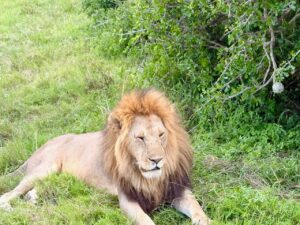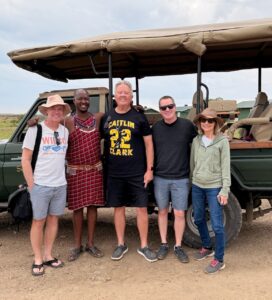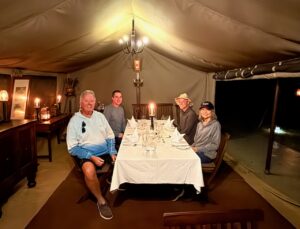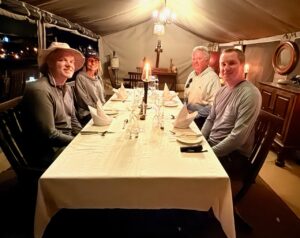
Would you go on an African safari?

See the animals!
We just finished an African Safari inside Kenya’s Masai Mara National Reserve. I can’t describe our experience of seeing the animals as well as I can show you, but I produced a couple of YouTube videos from our safari experience for your viewing pleasure.
If you are interested in the actual safari portion of our safari, I recommend you watch the videos. Check out the video links below. These videos are not well suited for young children. A lot of tough love occurs in the jungle day and night.

Massai Mara National Reserve – Part 1

Massai Mara National Reserve – Part 2

Free the animals from the zoo?
Sometimes, people say that wild animals should not be locked up in the zoo. I can understand part of that logic. However, wild animals in a zoo, are pretty well sure not to be killed by a predator. It is survival of the fittest in the Massai Mara National Reserve.

Costco? You’re kidding, right?
What was the most critical point in our preparation for our Kenyan safari? Costco! Yes, Costco!
Costco has a unique program for tourists visiting Africa. For just $39.95, they will list and recommend what shots and medicines you will need for your visit to wherever you might be going in Africa.

Do you need a visa?
Yes, you do. You can quickly get a Kenya visa online. My only advice is to take a good photo of yourself.

Do you need to get shots?
I’ve been to Africa many times. My “yellow card” lists all the shots I’ve taken in the past. Most of those do not need to be taken on every visit. The yellow fever vaccine is usually the most important. That said, when we entered Kenya, they never asked to look at our yellow cards or inoculation history.
We did take the malaria pill regimen and brought along a prescription for diarrhea. We ended up taking about 15 malaria pills, beginning before the trip and ending afterward. Luckily, diarrhea was not a problem for anyone. If you plan on taking an African safari, I strongly recommend exploring the services offered by Costco. Our health insurance fully covered all of our shots and medicines.
How about trip insurance?
We didn’t buy trip insurance, and we never do. Had we paid premiums for trip insurance for all of our trips (hundreds), we would have paid more in premiums than just about any incident or trip for that matter would have cost us.
Transportation?
Carol and I left Los Angeles and connected in Amsterdam on our way to Nairobi, Kenya. We flew in coach. I don’t mind flying long distances in coach, even at 6’3” tall.

I take a simple approach to flying, regardless of the distance. I get on the plane, entertain myself throughout the flight, and get off when the plane lands. Yes, I try to keep life simple. The total flight time for our two flights was 19 hours—that’s one way!

The group.
We would be joined by your oldest son, J.J., and his friend Dustin. They took a much more circuitous route. These guys like to fly business class and don’t mind going out of the way to do it.
They left Los Angeles and somehow ended up in Ethiopia on their way to Kenya. Don’t worry about J.J. and Dustin. They work in the airline business. They have likely forgotten more than I know about doing this.
They flew Ethiopian Airlines on one leg of the trip. Ethiopian Airlines has a unique benefit. If you have a long layover in Ethiopia, the airline will give you a complimentary hotel room at the price of your itinerary.

Uber? In Kenya? Really?
Did you know that the Uber rideshare folks offer their services worldwide? We used Uber several times. The driver typically showed up within five minutes of our call. Uber’s prices were lower than we would see in the United States.
Everything we bought in Kenya, including hotels, restaurants, and transportation, was less expensive than it would have been back home.

Kenya is both first-world and third-world.
We stayed at the Hyatt Regency in Nairobi. Each of us had an upgraded suite, which was the best room in the hotel. The hotel provided all the amenities Americans expect, including complimentary breakfast and unlimited food and drinks in the Regency Club. For that part of the trip, we felt right at home.


Nairobi touring.
I wouldn’t say that Nairobi has all that much to offer in terms of tourist attractions. We spent one day visiting the Karen Blixin Museum (above 1) and the Giraffe Centre (above 2), among other things. If you like taking a small nugget and placing it on the 6-inch tongue of a 12-foot giraffe, then you might like this place. That’s not exactly my idea of a good time.

One of the two best Nairobi touring choices.
I found the Kibera slum in Nairobi the most interesting. It is the largest slum in Africa, and estimates put the population at upwards of one million.

Kibera slum.
Wikipedia offered this information about Kibera.
“A survey conducted by the French Institute for Research in Africa found that the average Kibera slum resident lives in extreme poverty, earning less than US$2 per day. Unemployment rates are high. 12% of the population is living with HIV. Cases of assault and rape are common. There are few schools, and most people cannot afford education for their children. Clean water is scarce. Diseases caused by poor hygiene are prevalent. A great majority living in the slum lack access to basic services, including electricity, running water, and medical care.”
Kibera is the second-largest slum in the world. By 2030, one in four people will live in a slum or other informal settlement, which I find beyond unbelievable.
I commonly hire a driver during my world travel, taking me to 99 countries. I’ll ask that driver to take me to all of what I consider to be the most unusual tourist spots I can visit. That request always includes a visit to that area’s slums. Some drivers are more comfortable with that request than others.


Please don’t miss the Kibera slum video.
I also prepared a video of our two drives through the Kibera slum. One of those rides was with “Sam.” Sam (above with Carol) was 46. For the first 17 years of his life, Sam lived in the middle of the Kibera slum. When we drove through with him, we stopped, and he had conversations with several of his old friends who still live there.
The average lifespan of a Kenyan resident is only 54. Some research has told me that the average lifespan in the Kibera slums is 30 years. We spent about an hour driving through the slum. I can only imagine what this place would be like at night, with almost no electricity, running water, or indoor plumbing.


Was the food good in Nairobi?
The food in Nairobi during the trip was outstanding. Of course, the Hyatt is going to feed you a great breakfast. Then, we selected some of the most upscale Nairobi eateries, and one was as good as the next. Dining was as good in Nairobi as anywhere else I have visited.

How about a safari in the city?
Did you know that Nairobi has its own safari park, Nairobi National Park?
They offer one-day safaris in the park. We spent nearly an entire day with a driver as a warm-up for our Massai Mara National Reserve safari.

Stop. Can you name the “Big Five” in Africa?
The “Big Five” animals in Africa are the African lion, elephant, African buffalo, leopard and rhinoceros. For the entire trip, we would see all of the big five. We checked off the Nairobi National Park’s rhinoceros (above), elephants, buffalo, and lions. At the Massai Mara National Reserve, we saw all those animals except the rhinoceros and added the Cheetah.
Tigers? No tigers? Africa doesn’t have tigers. Want tigers? You gotta go to Asia to see tigers in the wild.

Trackchasing brought me to Kenya.
Of course, we saw some auto racing during the trip at the MX Kenya Rallycross event. That locked in country #88, where I’ve been able to pursue my hobby of trackchasing. I might return to Africa a time or two to trackchase in 2025. Stay tuned.

The Safari Company.
We organized our Safari in the Massai Mara National Reserve with The Safari Company in Kenya. They were professional and easy to work with. I recommend them. Here’s a link to their website if you are interested in a Kenyan safari or a safari in nearby countries.
Is an African safari as cheap as a Motel 6?
No. Going on a safari is an expensive undertaking. It costs a lot and takes time to get to where most Africans are. An all-inclusive safari will set you back a couple of bucks. Last time I checked, you can’t take it with you, so why not leave some of it in Africa? Remember, you subscribe to my newsletter, right? If you have been using some of my financial strategies, the price of a safari will be downright reasonable!

Top of the line or reasonable?
Of course, you don’t know exactly how it will turn out when planning a trip like this. We elected to stay in safari tents for our safari accommodations. I wouldn’t call our tents luxurious, but I would say the tents were upscale.

Our tents had showers, porcelain toilets, electricity, and comfortable beds. Other, more expensive options would have required us to stay in permanent buildings similar to hotels.

There are lots of camps to choose from.
We wanted to be out in the wild. We stayed in the Sentinel Mara camp. This camp has just ten tents. The camp’s expected occupancy would be around 20 people. We were lucky to be the only four people staying at the camp. We had the staff’s personal attention. Everyone in our group loved the exclusivity we enjoyed.
Were we out in the wild?
Our tent was about 75 yards from the center of the camp. At night, if we wanted to visit the camp’s lounges or other facilities, we were required to call a guard to walk us from our tent.
A huge pile of elephant dung was about ten feet from the entrance of our tent. We were told that even lions strolled through the camp at night. Our “guards” carried only a long broomstick to keep us safe!

Our camp overlooked a river. During the day, we could see 50 or more hippos lounging in the water to cool themselves off. By the way, the daily temperature during our November safari had a high of about 75 degrees, and nighttime lows might have been around 60. At night, the hippos continued to roar. The hippos come on land at night.

All meals are included in a typical safari. The Sentinel Mara Camp had a staff of around 15 people catering to just four people‘s needs. That’s a pretty good ratio.

The food was good. We ate some of our meals on our game drives. I’ve been on safari in South Africa, Namibia and Zimbabwe.

What’s a game drive?
A “game drive” means you hop in the truck and go out for a couple of hours in the morning and another two hours just before sunset. The goal is to see as many of Africa’s animals as possible. No, there wasn’t much between us and our subjects!
We saw many different animals and birds, but no tigers or monkeys. The animals would approach our truck and stroll past as if we were only a tree.
A good guide is so essential.
On the Safari, we had an excellent, experienced guide who could answer every question we asked and provided us with extensive background information about what we were seeing.
With our game drive, we could stay out for as long as we wanted each day. We could leave at 6 a.m. and come back by sunset, and we did that.

In the Massai Mara National Reserve, we weren’t in a jungle. The terrain was more like a grassy prairie. The landscape was mostly flat, with few trees.

The animals, especially the lions, could lay low in the tall grass. The other animals stood with their kind, looking out for the lions! Did you know that lions sleep around twenty hours each day?
On my previous safaris, lions were challenging to find. However, they were as plentiful as any other animal we saw in the Massai Mara. I was told that there are about 900 lions in the reserve.

This was a highlight.
One of the most surprising and interesting experiences was when we found a pride of lions eating their kill, a buffalo. The lions went after the buffalo’s meat, reducing it to its skeletal remains. We watched that experience for nearly an hour. Don’t miss the video.

The next day, we returned to the site of the kill. The Lions were gone. Now, the hyenas were taking their turn. I didn’t realize that hyenas eat the bones pretty much until there’s nothing left. Crunch! Crunch! Don’t miss the video. Only the skull and horns remained after the buffalo had gone through this experience. Yes, it’s tough love in the jungle (plains).
Each night, we had a bonfire. It was nice to sit around the fire and talk about the day’s events. We enjoyed as many cocktails as we wanted. There were no bugs or mosquitoes. During most trips, I was the first to be bitten. Others in our group did get a few mosquito bites. We took our malaria pills daily.
Each night, dinner was served after we finished our bonfire. Again, we liked the idea of being the only four people in the place. We didn’t have to wait for anyone else and enjoyed having the entire place to ourselves.

During our tour, we saw a BBC television crew filming a documentary. They were riding around in the same kind of truck as we were.
Is a safari dangerous?
This was Carol’s first safari. She had always told me she didn’t want to come to Africa. Why. Carol told me she didn’t “want to get eaten by lions.” Who does, right?

In the first few minutes of our game drive, our guide informed us that lions and none of the other animals would jump into our truck after I asked the question. That sounded like good news.
As you will see from the videos, we were often within 4-5 feet of lions, leopards, elephants, and many other wild animals. There was absolutely nothing between us and them. In the truck, we were only four feet off the ground. This would have been a bad place to drop your phone.
Communication?
Speaking of phones, I used my iPhone exclusively to take pictures and videos. I could text, call, and check email everywhere we went in Kenya. That’s sometimes good and oftentimes less than good. The phone makes the big world very small. Nevertheless, that is the world we now live in.
This was our safari highlight.
The most dramatic experience in our safari was watching a couple of female lionesses track and ultimately take down a baby Eland. Elands are in the elk family.
The lions were probably 500 yards from their prey. They would walk about 50 yards and then crouch down in the grass as they stalked their prey, a full-size Eland mother and her four-week-old baby.


When the lions got within yards of it, they put on the full-court press and were able to take down the baby. Our guide told us if the baby had been just a month older, it could have run fast enough to stay out of the lion’s reach. Lions can run fast but can’t run more than 100 yards or so at speed. When the baby was down, the Eland mother could only keep a safe distance and mourn the demise of her baby.
That experience was heartbreaking. However, in the jungle, it is the survival of the fittest. For pretty much every animal in the reserve, there is a predator. Who is the predator of the lion? Humans.
Africa is a long way from where most folks reading this live. Safari is quite the experience.
How long should your safari be?
Of course, only you can decide that. After three days, I found the game drives becoming repetitive. I don’t think I would have much interest in going on a safari for many more days than that. That’s just me.
Will you take the time?
I produced three videos for you to view. I know that people are busy and don’t want to spend much time on one topic before swiping to the next. Again, that is the world we live in. However, I recommend you take just two minutes to watch one of the videos and decide if you want to watch more.
Two videos are from an animal Safari in the Massai Mara National Reserve, about five hours west of Nairobi, Kenya.
Massai Mara National Reserve – Part 1
Massai Mara National Reserve – Part 2
The third video is from our tour of the Kibera slums in Nairobi.
If you watch the Safari videos, you can compare it to your own experience. If you haven’t done a safari yet, this might give you some indication of what you are likely to see. You can then decide whether or not you want to invest the time, energy, and finances into a project like this.

Safaris are a wonderful vacation for families.
We all had a fantastic time. Yes, a safari is a great family experience.
Kenya last week, the “city” next week.
Tomorrow, Carol and I are heading to New York City to spend several days in Manhattan during Christmas. New York is my favorite city in the world, and going there during the Christmas season is extra special.
So long, from Nairobi, Kenya. I’m not sure I’ll ever be back to Kenya but going there once lived up to every expectation I had and more.

Randy Lewis
Not afraid to be eaten by lions

